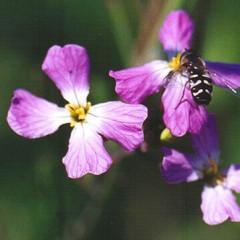
Wild Radish
Raphanus sativus. Erect annual in high marsh zone and disturbed, weedy terrestrial habitats. A much-branched herb to 4′ tall, bristly toward the base and arises from a dense rosette of stalked, lobed, rough-to-touch leaves that usually wither before flowering. Stem leaves are smaller. Flowers 4 petalled, white, yellow or lilac colored flowers with 6 stamens, petals do not overlap. Vegetative state can be confused with black mustard (yellow flowers).
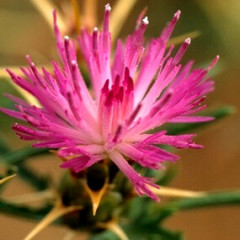
Purple Star-Thistle, Iberian Star-Thistle
Centaurea calcitrapa, Centaurea iberica. Annual to perennial, mounding growth habit, 30 cm – 1 m tall. Plants form rosettes first growing season, the leaves deeply pinnately lobed and gray-hairy with light-colored midribs; older rosettes have a circle of spines in the center. Mature plants densely and rigidly branched, and have numerous spiny purple flowers surrounded by long, stout, sharp-pointed spines. Purple starthistle is like Iberian starthistle, which is also found in California, but differ in seed shape and bristles under flower head.
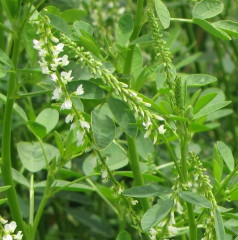
White Sweetclover
Melilotus alba. Cultivated forage plant for bees, livestock and wildlife, escaped . Annual or biennial legume that can reach anywhere from 3-6′ tall. Taproot with lateral roots having N fixing nodules like other legumes. Round light green stems slightly terete (furrowed on all sides), glabrous (smooth), and often branched. The 0.5-1″ long alternate trifoliate leaves are sparsely distributed on stem . Narrow racemes of white flowers about 0.25-1″ long have tendency to hang downward from the central stalk of the raceme. Invasions can alter plant communities by changing the pollination and reproductive success of native plants.
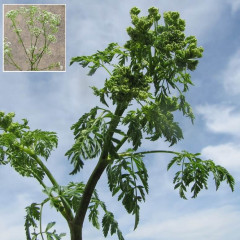
Poison Hemlock
Conium maculatum. Ornamental biennial from Europe starts as ground-level rosette. then grows tall stems 3-10′ tall. Leaves have fern-like appearance, finely divided. Ribbed, hollow stem has purplish streaks or splotches. Small, white flowers grow in many umbrella-shaped clusters, each supported by a stalk. When crushed, they have a rank odor. Toxic: alkaloids depress central nervous system and can be fatal if consumed.
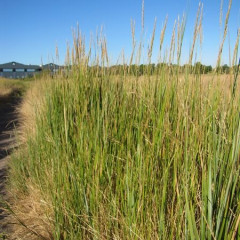
Beardless Wild Rye, Creeping Wild Rye
Elymus (Leymus) triticoides. Common to dry to moist saline meadows, tolerates alkaline soils. Cool season, strongly rhizomatous, perennial grass, forming a monoculture sod 40 cm to 1 m tall. Long leaf blades green to blue green, stiff, roll up a little under dry conditions. Narrow long spike seed head, 5-15 cm long. Currently used for soil stabilization and wildlife habitat.
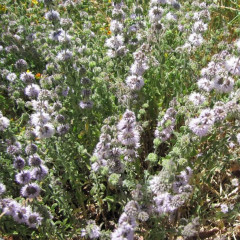
Pennyroyal
Mentha pulegium. Low growing rhizomatous perennial to 1.5′ tall, escaped from cultivation. Square stems covered with short, white hairs. Opposite and paired gray-green leaves emit strong spearmint fragrance when crushed. Pink-purple flower heads in whorls of many flowers on cylindrical spike up to 6″ long, with floral leaves underneath and bare stem between clusters. Prolific in flooded areas because it can germinate and survive under shallow water where most other plants die. Pennyroyal is a traditional folk remedy and culinary herb. Pennyroyal is frequently used as insecticide and pest repellent. Pennyroyal oil can be extremely toxic to both humans and animals, even in small quantities.
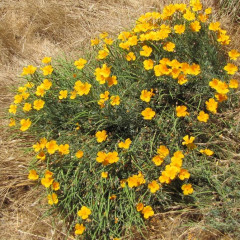
California Poppy
Eschscholzia californica. State perennial flower found on arid soils, tolerates serpentine soil. Leaves alternately divided into round, lobed segments. Blooms throughout summer. Orange petals close at night. Coastal variety more yellow. When fruit dry out, they split and pop out seeds spreading several feet. Travelers are advised not to eat any food with poppy seed since it can trigger a false positive in drug testing.
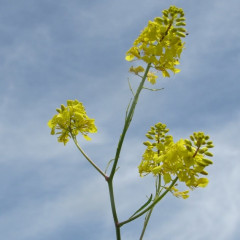
Black Mustard
Brassica nigra. Winter annual crop from Europe now naturalized. Can be confused with other mustards and radish. Flowers have 4 sepals and 4 clawed, lemon yellow petals, with six stamens, 4 long and 2 short as is characteristic of mustards, and curling anthers. Grows profusely and produces allelopathic chemicals that prevent germination of native plants.
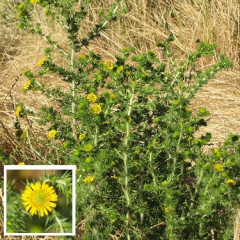
Spikeweed, Common Tarweed
Hemizonia pungens. Annual up to 6′ tall, starts as rosette, stems branch rigidly ascending, tap-rooted. Yellow green leaves, upper leaves alternate, awl like, spine tipped, clusters of leaves in axils, +/- strong tarweed scent. Yellow ray and disc flowers in summer, chaffy bracts, spine tipped. Desirable part of ecosystem as food source, but weedy in pastures and NW State agriculture
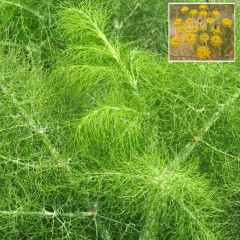
Fennel
Foeniculum Vulgare. Perennial, erect, hairless, aromatic herb 2 m tall with large taproot and finely dissected feathery leaves. Yellow flowers in terminal compound umbels 2-6″ across, May-September. Cultivated worldwide for leaves and fruits. Seeds taste like anise, but not as strong. Food source for butterfly larvae and birds.
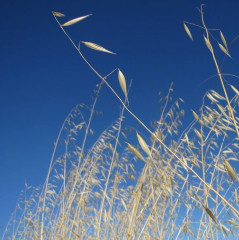
Wild Oat
Avena fatua. Erect cool season annual grass with extensive fibrous root system. Stems round and hairless, over 3′ tall. Leaves flat, rolled in the bud, 2′ long. Tall membranous ligule with a rounded jagged top at collar region. Open branched nodding flower cluster of spikelets. Old variety of field oat planted earlier becoming weedy today.
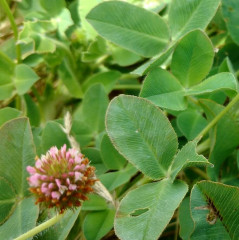
Clover
Trifolium spp. There are over 200 species in the genus Trifolium, Nonnative introduced from Europe used in agriculture and lawns. Leaves usually trifoliate. White clover, R. repens, used to be added to lawn seed before synthetic fertilizers since they are nitrogen fixing plants with symbiotic bacteria in the root nodules. A favorite plant for native and honey bees.
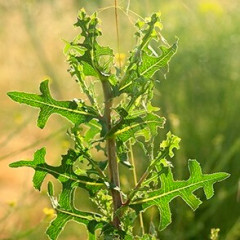
Prickly Lettuce
Lactuca serriola. Common winter annual or biennial that starts as basal rosette. Erect spineless reddish stem containing milky latex up to 6′ tall. Lower portions of stems may have bristly hairs. Waxy grey-green alternate leaves get progressively smaller as they reach its top and are egg shaped, deeply lobed or unlobed, with prickly edges, a row of prickly bristles on the lower midvein and undersides have whitish veins. Stems branch at the flower head containing small pale-yellow dandelion like flowers from April through October.
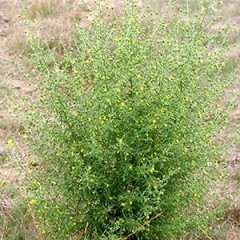
Stinkwort
Dittrichia graveolens. Erect, fall-flowering annual, up to 2′ tall. Small linear to linear-oblanceolate leaves on stem have sticky glandular hairs covered in resin which emit strong aromatic odor that resembles smell of tarweeds. Small flowerheads with yellow to reddish disk flowers centers and short yellow ray flowers outer edge. Mediterranean native spreading rapidly throughout the world. Not palatable to animals, poisonous to livestock, and causes contact allergic dermatitis in humans
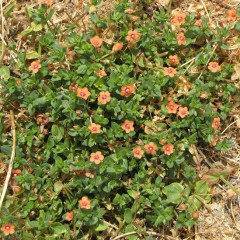
Scarlet Pimpernel
Lysimachia arvensis. A low growing annual with creeping habit. Bright green soft oval leaves directly attached to opposite sides of stems. Five petal salmon colored or sometimes blue colored radially symmetric flowers are produced singly in leaf axils. A poisonous weed from Europe found along roadsides and disturbed areas. When eaten by animals and humans causes gastroenteritis and fatality.
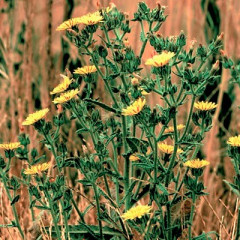
Bristly Ox-tongue
Helminthotheca echinoids. Up to 1 m tall with coarse branching stems with milky sap . Young plant with rosette leaves before bolting in Spring. Stem leaves oblong, alternate, 5–20 cm long, evenly bristly. Yellow flowers like dandelions. Rubbing the plant on skin can cause a severe rash . Has been used as an antihelminthic treatment for internal worm/nematode parasites.
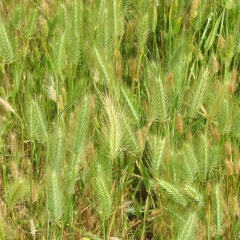
Meadow Barley
Hordeum brachyantherum. Perennial in mixed vegetation valley grasslands. Ssp. brachyantherum is upright, while closest relative, California barley ssp. californicum, is shorter, more spreading. Growth habit open tuft with erect to slightly spreading, smooth stalks (culms) 1-3′ tall. Flower head a narrow, flattened spike, 2-4″ long, purplish in color, with bristle-like awns and a brittle central axis that breaks off in pieces from top down at maturity.
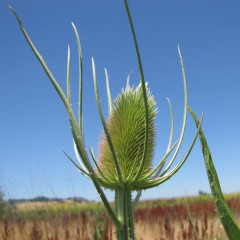
Teasel, Wild Teasel
Dipsacus fullonum. Biennial ornamental imported from Europe, now invasive. First year rosettes develop taproot, then tall flowering stalk second year up to 6′ tall. Flowers packed in dense oval shaped spiny inflorescence at top of spiny stem. Common Teasel has pink or purple flowers, straight flower bracts, stem leaves slightly fused at base. Fullers Teasel has white flowers, curve down flower bracts, and stem leaves strongly fused at base.
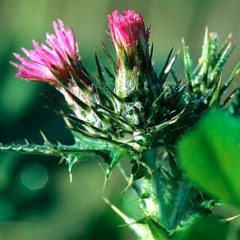
Italian Thistle
Carduus pycnocephalus. Winter annual or biennial starts as rosette with taproot then develops tall prickly winged stems up to 6′ tall. Prickly, lanceolate leaves deeply cut into 2-5 pairs of spiny lobes, grow on stem. Flower heads thimble-sized, pink to purple flowers clustered in groups of 2-5 covered with densely matted, cobwebby hairs. Dense infestations and spines discourage foraging by stock and wildlife.
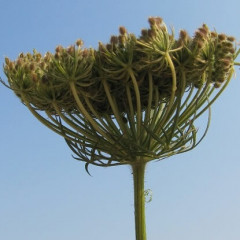
Queen Anne's Lace, Wild Carrot, Bird's Nest
Daucus carota. Same species as domestic carrot. Biennial, stiff solid stems with short white hairs, 30-60 cm tall (no purple spots like Poison Hemlock). Leaves tripinnate (finely divided and lacy) and triangular shaped, smell like parsley. Flowers small white clusters on flat dense umbels 10 cm across, spent umbels curl inwards forming “bird’s nest”. Entirely edible with herbal medicinal values e.g. diuretic, stimulant, contraceptive, and abortive. Companion crop in blueberries to attract beneficial insect.
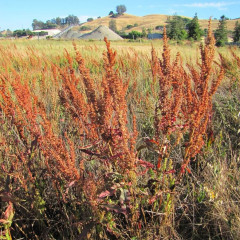
Curly Dock
Rumex crispus. Common agricultural weed produces thousands of seeds, grows in wet, disturbed areas. New basal rosettes of leaves form in early winter over a taproot and the then grows erect unbranched stems 1.5-5′ tall which dies back in mid to late summer, turns distinctive rusty brown. Hairless leaves are alternate to one another along the stem. It has chemical defenses to reduce herbivory.
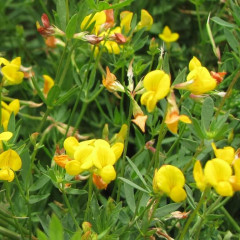
Bird's-Foot Trefoil
Lotus corniculatus. A mat-forming perennial with stems up to 3′ long. Yellow flowers –pea type, orange center on some. Foliage is distinct blue green color with 5 leaflets. Tap root and lateral roots develop nitrogen fixing nodules. Cultivars used for pasture forage and hay.
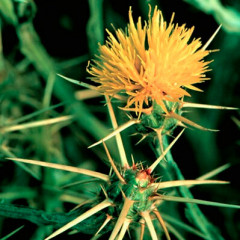
Yellow Star Thistle
Centaurea solstitialis. Gray-green to blue-green annual plant, 15 cm–1 m tall with a deep, vigorous taproot. Bright yellow thistle like flowers with sharp spines surrounding the base can produce 10,000 seeds per plant. Stems rigid, spreading, and typically branching from the base, covered with a loose, cottony wool giving whitish appearance and appear winged - leaf bases extend beyond the nodes. Basal leaves 2-3″ long and deeply lobed while upper leaves short (0.5-1″ long) and narrow with few lobes. Impacts native plant diversity, altering water cycles, and poisoning livestock . Biological control with Mediterranean insects used with minor success
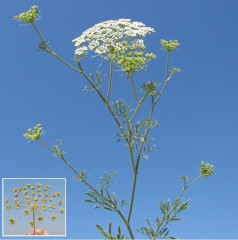
Greater Ammi, Queen Anne's Lace
Ammi majus. Annual/biennial, like water hemlock & wild carrot, upland. TOXIC to livestock/water fowl – contains furocoumarins, nitrates. Glabrous stems 3′ tall with taproot. Glabrous compound leaves pinnately dissected 1-3 times, leaflets lanceolate, 0.25-1″ long, margins serrated, upper leaflets linear. Small white flowers, 5 petals, on compound umbels, 20-60 clusters, spreading, bracts pinnately dissected and linear. Fruits ovate with narrow ribs. Cultivated for dry flower arrangements, medicinal.
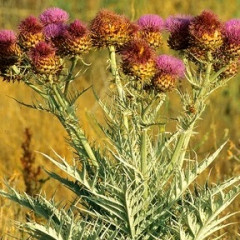
Cardoon, Artichoke
Cynara cardunculus. Also called Artichoke Thistle. From Mediterranean area, grown as a vegetable in older times and used in landscaping currently. Large, deeply lobed leaves, with white downy hair making them pale grey green in color. Leaves, stems and fruit spiny – causes pain. Large violet-purple flowers in capitulum.
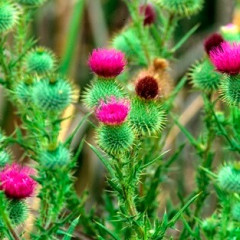
Bull Thistle
Cirsium vulgare. Branching, erect biennial, 2-6′tall with taproot. Stems stiff and thorny. Leaves rosette first year, mature leaves deeply lobed and hairy that end in extended, very sharp thorns and are beige in color. Blooms second year from June to September with large solitary purple gumdrop-shaped flower heads, spines extend all around base.
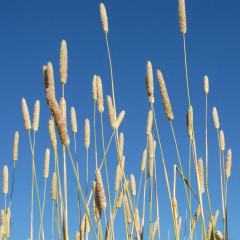
Harding Grass
Phalaris aquatica. Common to roadsides and vacant lots. Erect waist high stout perennial bunch grass . Grayish to bluish green leaves. Compact panicle seed head on long stalks. Planted for forage and fire repair. Spreads by seed and rhizome. Imported earlier for pastures but has low nutritive value for livestock.
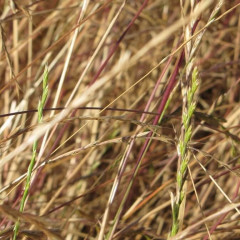
Italian Wild Rye, Rye Grass
Festuca perennis (Lolium multiflorum). Widespread nonnative grass in fields, roadsides, disturbed areas across temperate world since widely planted as cover crop, forage, and lawn. Found in high and middle brackish tidal marsh zone. Can form dense mat monoculture. Narrow solitary spike 4-12″ long, regularly spaced alternately arranged spikelets attach edgewise directly to flowering stem.
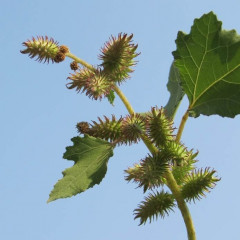
Cocklebur
Xanthium strumarium. Common annual weed to 1.5 m tall with thick taproot that likes moist, disturbed areas. Large leaves with distinctive scent, broadly triangular, weakly three lobed, rough to the touch. Spineless stems. Large football shaped burred fruit mostly 0.5 to 1.7″ long with beaklike hooks at tip were the inspiration for Velcro. Toxic to livestock, burs a boon to sheep wool cleaning.




